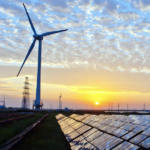The smart grid is transforming the way utilities communicate with their customers. Smart grid technology, including control systems and automation that help new technologies work together, supports a power grid that can respond digitally to quickly changing electricity demand.
The smart grid enables electricity producers to enhance reliability, availability, and efficiency. It can provide cost savings—both for utilities and consumers—and even environmental benefits. It will allow for faster restoration of power after outages, and supports better integration of distributed generation resources, including renewable energy, to the larger grid. It also supports grid integration of large-scale renewable energy resources.
It also is designed to improve the security of the grid, enabling power generators, along with transmission and distribution operators, to recognize and respond more quickly to grid anomalies.
The smart grid will be a focus of POWER’s upcoming Connected Plant Conference, set for February 25-27 at the Westin Peachtree Plaza in Atlanta, Georgia. In advance of the event, POWER talked with Brian Van Heel, director of PV Inverters and Energy Storage at Fremont, California-based Delta Electronics (Americas), to get his views on the smart grid.
POWER: What are some of the benefits of smart grid technology?
Van Heel: “A true smart grid should be able to perform certain functions without direct human control. It can recognize irregularities within the utility grid and automatically adjust to increase energy efficiency and resiliency. Because of this, smart grids create environmental and cost benefits by reducing the amount of energy wasted and improving efficiency of generation, delivery and consumption.”
POWER: Can you talk about advancements in digital automation technology that are facilitating the growth of the smart grid?
Van Heel: “Data streams are needed to inform decisions within a smart grid. Advancements in the IoT [Internet of Things] are enabling the smart grid to become more interconnected with the technologies that comprise it. 5G’s low latency is going to be a major step forward for the industry—especially since we could (theoretically) have more than 100 billion interconnected devices that make up the smart grid within the next 20 years. When 5G advancements are eventually combined with edge computing, the grid will become exponentially more responsive and autonomous.”
POWER: How is this technology enhancing the sustainability and even the reliability of the power distribution system?
Van Heel: “The advancement and adoption of microgrids, combined with the general compartmentalization of the power grid, is creating more resiliency. This is critical during times of extreme weather. Take the recent California wildfires as an example. The utility [Pacific Gas & Electric] was forced to initiate large blackouts due to the greater threat of wildfires being caused by high wind and downed power lines. In the future, we’ll have a more compartmentalized power grid where a smaller, more surgical strike can be made to cut off power to only segments of the grid that are in the path of immediate danger. For any homes or businesses that may lose power, solar plus storage offers the solution to keeping the lights on. The added benefit of microgrid adoption is that it puts the control of power generation into the hands of homeowners, business owners and communities, breaking up the large monopoly utility companies currently hold.”
POWER: How does the smart grid support development of renewable power such as solar and wind, and how could it be used to support growth in the electric vehicles sector?
Van Heel: “We are already seeing a variety of different power sources being deployed to reduce carbon footprint. Any grid will want to support these efforts and can by using a combination of complementary power. Widespread adoption of electric vehicles will increase the demand on the power grid when they charge up. Adding more solar and wind power generation to the grid can be used to offset this extra burden. “
POWER: How can smart power meters increase energy efficiency and support communications between power suppliers and customers?
Van Heel: “A smart power meter’s main function is to recognize usage patterns. Knowing the consumption profile of a building is important, especially in locations where demand charges are implemented. Once you know how and when energy is being used, adjustments can be made to reduce consumption during times of peak demand when energy is the most expensive. Smart meters are also necessary to participate in demand response or automated demand response programs.”
POWER: Can the smart grid help prevent widespread power disruptions? Can it shorten outage times?
Van Heel: “Smart grid power distribution ties back to the concept of compartmentalizing the power grid and relying on a more diverse set of energy sources, including renewables. In light of recent moves by utilities, there has been an uptick in interest around solar plus storage solutions from homeowners looking to ensure greater reliability of and control over their power supplies. Because of this, the industry is seeing an uptick in solar plus storage backup systems that can limit disruptions and reduce downtime when they occur.”
(Editor’s note: To learn more about the smart grid, read “Evolution of the Smart Grid at Forefront of Transformative Change” in the January 2020 issue of POWER.)
—Darrell Proctor is a POWER associate editor (@Darrell Proctor1, @POWERmagazine).










